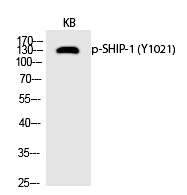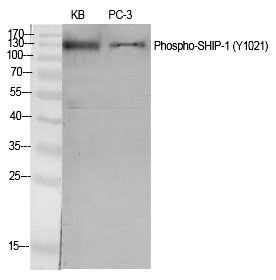

| WB | 咨询技术 | Human,Mouse,Rat |
| IF | 咨询技术 | Human,Mouse,Rat |
| IHC | 咨询技术 | Human,Mouse,Rat |
| ICC | 技术咨询 | Human,Mouse,Rat |
| FCM | 咨询技术 | Human,Mouse,Rat |
| Elisa | 1/40000 | Human,Mouse,Rat |
| Aliases | INPP5D; SHIP; SHIP1; Phosphatidylinositol 3; 4,5-trisphosphate 5-phosphatase 1; Inositol polyphosphate-5-phosphatase of 145 kDa; SIP-145; SH2 domain-containing inositol 5'-phosphatase 1; SH2 domain-containing inositol phosphatase 1; SHIP-1; |
| Entrez GeneID | 3635; |
| WB Predicted band size | 133kDa |
| Host/Isotype | Rabbit IgG |
| Antibody Type | Primary antibody |
| Storage | Store at 4°C short term. Aliquot and store at -20°C long term. Avoid freeze/thaw cycles. |
| Species Reactivity | Human,Mouse,Rat |
| Immunogen | Synthesized peptide derived from human SHIP-1 around the phosphorylation site of Y1021. |
| Formulation | Purified antibody in PBS with 0.05% sodium azide,0.5%BSA and 50% glycerol. |
+ +
以下是关于SHIP-1 (Phospho-Tyr1021)抗体的3篇参考文献的简要列举:
1. **"Role of SHIP-1 in the regulation of B cell receptor signaling"**
- **作者**: Ono, M. et al.
- **摘要**: 本研究通过Phospho-Tyr1021特异性抗体,揭示了SHIP-1在B细胞受体信号中的负调控作用,磷酸化Tyr1021位点介导了其与下游效应分子的结合,抑制PI3K-Akt通路活化。
2. **"SHIP-1 tyrosine phosphorylation in mast cell activation and allergic responses"**
- **作者**: Huber, M. & Krystal, G.
- **摘要**: 利用抗Phospho-Tyr1021抗体,作者发现肥大细胞中SHIP-1的Tyr1021磷酸化由FcεRI交联触发,并通过招募CIN85调控脱颗粒过程,影响过敏反应。
3. **"Dysregulated SHIP-1 phosphorylation in leukemia pathogenesis"**
- **作者**: Lamkin, T.D. et al.
- **摘要**: 通过免疫印迹和免疫沉淀(使用Phospho-Tyr1021抗体),研究证明慢性粒细胞白血病中BCR-ABL激酶异常磷酸化SHIP-1的Tyr1021.导致其酶活性丧失,促进癌细胞存活。
4. **"Inhibitory receptor signaling via SHIP-1: Phosphorylation-dependent mechanisms"**
- **作者**: Pauls, S.D. et al.
- **摘要**: 该研究利用Tyr1021磷酸化特异性抗体,阐明抑制性受体(如PIR-B)通过激活Syk激酶磷酸化SHIP-1的Tyr1021.募集Shc适配蛋白,从而负向调控免疫细胞活化。
以上文献均通过Phospho-Tyr1021抗体揭示SHIP-1在不同生理/病理过程中的分子机制,涵盖免疫调控和疾病模型研究。
The SHIP-1 (Phospho-Tyr1021) antibody is designed to detect the phosphorylated form of SH2 domain-containing inositol 5-phosphatase 1 (SHIP-1) at tyrosine residue 1021. SHIP-1. encoded by the *INPP5D* gene, is a lipid phosphatase that regulates cellular signaling by hydrolyzing phosphatidylinositol-3.4.5-trisphosphate (PIP3) to phosphatidylinositol-3.4-bisphosphate (PI-3.4-P2), thereby modulating PI3K/Akt and other signaling pathways. Phosphorylation at Tyr1021 is a critical post-translational modification triggered by receptor activation (e.g., FcγR, cytokine receptors) or immunoreceptor tyrosine-based inhibitory motif (ITIM) signaling. This modification facilitates SHIP-1's interaction with adaptor proteins like Shc and Grb2. enabling its recruitment to signaling complexes for downstream regulatory functions.
The antibody is widely used in research to study SHIP-1 activation in immune cells (e.g., B cells, mast cells, macrophages) and its role in negative regulation of immune responses, hematopoiesis, and cancer. Its specificity for phosphorylated Tyr1021 makes it valuable for detecting SHIP-1 activation status in Western blotting, immunofluorescence, or immunoprecipitation. Dysregulation of SHIP-1 phosphorylation is implicated in autoimmune diseases, leukemias, and inflammatory conditions, underscoring its relevance in both basic and translational studies. Proper experimental controls (e.g., phosphorylation inhibitors, SHIP-1 knockout cells) are recommended to validate antibody specificity.
×